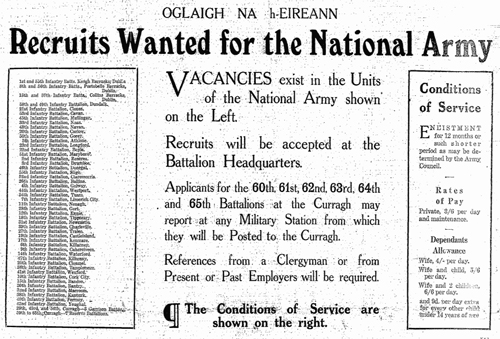National Army begins recruitment drive to combat ‘campaign of destruction’
26 January 1923, Dublin - Long queues of young men were reported outside recruitment centres in Dublin in response to an urgent appeal for new recruits to the National Army.
An official at the Brunswick Street recruitment office claimed that if volunteers continued to present in the same numbers in the coming days as they have in recent days, all vacancies could be filled within the week. The appeal seeks men for temporary service under a contract for twelve months or less.
Advertisements have been published in the press which outline the conditions of service, the rates of pay and the allowances for dependents, wives and children. They have also outlined all the units countrywide for which vacancies exist. Recruits will be accepted at each of the Battalion headquarters, the advertisements state, with references from a clergyman or from a past or present employer required.

Recruiting office on Brunswick Street (Image: Irish Independent, January 27 1923)
Under the terms of the Anglo-Irish Treaty the size of the Irish army is expected to be proportionate to the general populations of the two countries with the figure agreed upon by each government set at approximately 35,000. Given the current uncertain conditions in Ireland, however, it is believed the British government would not oppose an expansion beyond this number.
In a message accompanying the new recruitment drive, General Mulcahy has stated that the ‘whip hand in the campaign of destruction against the fabric of the industry and the country shows itself to have passed irretrievably from those who, talking patriotism, played with destruction, to those who are apparently destroyers by nature.. All pretence of patriotic thought or responsible feeling has been cast aside, and a campaign of blind destruction has been entered on.’
The call for recruits comes at a time when the Irish army is also undergoing a major reorganisation, which involves the abolition of the existing system of brigades and divisions and the removal of the ranks of Commandant-General, Brigadier, Colonel-Commandant and Lt. Commandant. A new structure of organisation will see the country divided into nine separate commands, each with a Major General in charge. The nine commands are: Donegal Command, Athlone Command, Claremorris Command, Dublin Command, Waterford Command, Limerick Command, Curragh Command, Kerry Command and Cork Command. General Mulcahy will remain as Commander in Chief and Seán MacEoin, promoted from Major-General, continues to serve as Chief of Staff.
British Pathé newsreel footage of events in Ireland in 1923
[Editor's note: This is an article from Century Ireland, a fortnightly online newspaper, written from the perspective of a journalist 100 years ago, based on news reports of the time.]





















